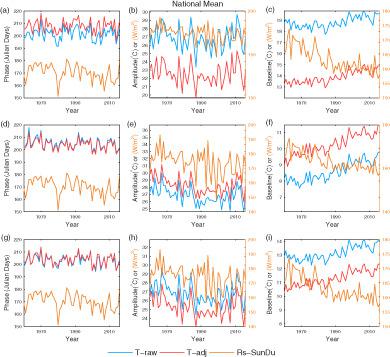当前位置:
X-MOL 学术
›
Int. J. Climatol.
›
论文详情
Our official English website, www.x-mol.net, welcomes your
feedback! (Note: you will need to create a separate account there.)
Temperature annual cycle variations and responses to surface solar radiation in China between 1960 and 2016
International Journal of Climatology ( IF 3.5 ) Pub Date : 2020-10-17 , DOI: 10.1002/joc.6895 Runze Zhao 1 , Kaicun Wang 1 , Guocan Wu 1 , Chunlue Zhou 2
International Journal of Climatology ( IF 3.5 ) Pub Date : 2020-10-17 , DOI: 10.1002/joc.6895 Runze Zhao 1 , Kaicun Wang 1 , Guocan Wu 1 , Chunlue Zhou 2
Affiliation

|
The annual temperature cycle affects atmospheric circulation, biomass cycling, and human life. Its variation is influenced by surface solar radiation, which plays a key role in surface energy budgets. In this study, the Fourier transform method is used to analyse the spatial distribution and long‐term variations in temperature phase, amplitude, and baseline terms between 1960 and 2016 in China. Mean surface air temperature has a north–south gradient for phase, amplitude, and baseline. The regional mean phase values of the maximum, minimum, and mean temperatures in South China are larger than in North China, indicating that the timing of the annual cycle in Southern China is several days later than in Northern China. At the national scale, the annual maximum, minimum, and mean surface air temperature cycles are advancing, decreasing in range, and have a rising baseline. Linear regression is used to quantify the effect of surface solar radiation on temperature by removing its contribution on the raw maximum and mean temperatures. The surface solar radiation increases the phase of maximum and mean daily air temperatures, but reduces the amplitude and baseline. The surface solar radiation effect on maximum temperature is especially significant on the Yunnan‐Guizhou Plateau located in the south‐southwest. The phase of maximum temperature adjusted for solar radiation for the Plateau is similar to South China at the same latitude and later than the raw maximum temperature.
更新日期:2020-10-17











































 京公网安备 11010802027423号
京公网安备 11010802027423号